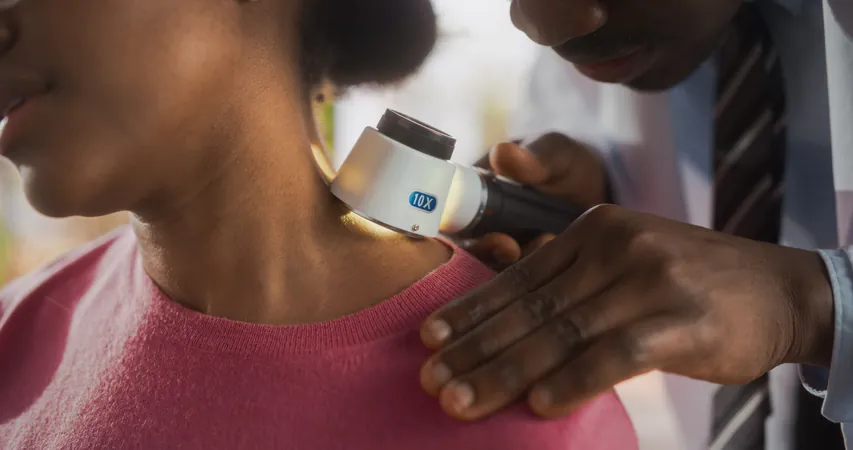
Shocking Study Reveals Startling Gaps in Skin Tone Representation in Nursing Education
2024-11-13
Author: Yu
Recent research has unveiled a shocking reality in medical education: a pervasive and harmful phenomenon known as 'visual racism.'
This term refers to the significant underrepresentation of darker skin tones in nursing textbooks, an oversight that can have dire consequences for healthcare outcomes. The failure to accurately depict diverse skin tones has resulted in delayed or missed diagnoses, particularly for dermatological conditions, thereby perpetuating disparities within the healthcare system.
The Alarming Reality
Historically, medical education materials have consistently prioritized lighter skin tones, leaving future healthcare providers inadequately prepared to diagnose and treat conditions in patients with darker complexions. This imbalance is exacerbated by clinical training resources that tend to focus on lighter skin for non-stigmatized conditions, neglecting the nuances required for recognizing disease presentations in diverse populations. With organizations like the National Academies of Sciences and Engineering emphasizing the necessity for inclusive care, it has become imperative to rectify this representation gap.
Study Insights
A recent comprehensive study scrutinized eight commonly used pediatric nurse practitioner (PNP) textbooks to assess their visual representation of Fitzpatrick skin types IV to VI, which correspond to darker skin tones. The researchers applied strict Strobe guidelines in a quantitative observational study, categorizing images, illustrations, and videos according to the Fitzpatrick scale.
Out of a staggering 2,112 images reviewed, only 28% displayed darker skin tones, and the representation dropped further in illustrations and videos to a mere 2.5% and 9%, respectively. Alarmingly, the study found that images relating to stigmatized health issues—such as child abuse or sexually transmitted infections—were disproportionately populated by images of individuals with darker skin, reinforcing harmful stereotypes.
The Broader Impact
These findings have profound implications for clinical practice. They highlight the urgent need for improvements in clinical training materials, as effective diagnosis and patient care for individuals with darker skin tones depend heavily on visual learning. Conditions like melanoma, commonly misdiagnosed in darker skin, can lead to severe health consequences if not properly recognized in time. This visual bias directly affects the capabilities of future clinicians to detect early signs of skin cancers and inflammatory skin disorders, placing patients at risk for delayed treatments and poorer health outcomes.
A Call for Change
The study urges dermatology professionals and educational institutions to champion for equitable representation in clinical resources. By incorporating diverse images depicting dermatologic conditions across all Fitzpatrick skin types in textbooks and training materials, the accuracy of diagnoses and overall patient outcomes can be significantly improved.
Conclusion: Time for Action
The systemic under-representation of dark skin in medical education is not merely an academic issue—it poses a hazardous barrier to equitable healthcare. Addressing visual racism in education is not just a matter of fairness; it has real stakes in determining healthcare outcomes for diverse populations. Dermatology clinicians, educators, and healthcare institutions must unite to eradicate visual bias and ensure that every skin tone is accurately represented and trained upon, paving the way for a more inclusive and effective healthcare environment for all.
With these critical changes, we can move towards a future where no patient is marginalized due to the color of their skin. Don't let this issue remain in the shadows—advocate for diversity in healthcare today!


 Brasil (PT)
Brasil (PT)
 Canada (EN)
Canada (EN)
 Chile (ES)
Chile (ES)
 España (ES)
España (ES)
 France (FR)
France (FR)
 Hong Kong (EN)
Hong Kong (EN)
 Italia (IT)
Italia (IT)
 日本 (JA)
日本 (JA)
 Magyarország (HU)
Magyarország (HU)
 Norge (NO)
Norge (NO)
 Polska (PL)
Polska (PL)
 Schweiz (DE)
Schweiz (DE)
 Singapore (EN)
Singapore (EN)
 Sverige (SV)
Sverige (SV)
 Suomi (FI)
Suomi (FI)
 Türkiye (TR)
Türkiye (TR)